中高温压力传感器
- 格式:doc
- 大小:31.50 KB
- 文档页数:2
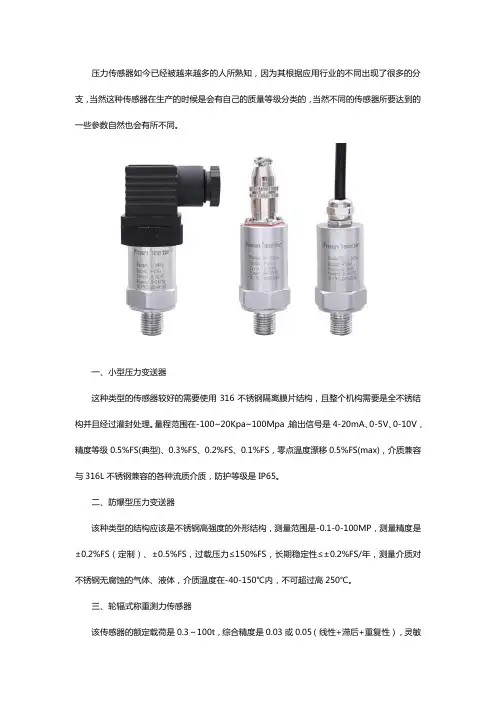
压力传感器如今已经被越来越多的人所熟知,因为其根据应用行业的不同出现了很多的分支,当然这种传感器在生产的时候是会有自己的质量等级分类的,当然不同的传感器所要达到的一些参数自然也会有所不同。
一、小型压力变送器这种类型的传感器较好的需要使用316不锈钢隔离膜片结构,且整个机构需要是全不锈结构并且经过灌封处理。
量程范围在-100~20Kpa~100Mpa,输出信号是4-20mA、0-5V、0-10V,精度等级0.5%FS(典型)、0.3%FS、0.2%FS、0.1%FS,零点温度漂移0.5%FS(max),介质兼容与316L不锈钢兼容的各种流质介质,防护等级是IP65。
二、防爆型压力变送器该种类型的结构应该是不锈钢高强度的外形结构,测量范围是-0.1-0-100MP,测量精度是±0.2%FS(定制)、±0.5%FS,过载压力≤150%FS,长期稳定性≤±0.2%FS/年,测量介质对不锈钢无腐蚀的气体、液体,介质温度在-40-150℃内,不可超过高250℃。
三、轮辐式称重测力传感器该传感器的额定载荷是0.3~100t,综合精度是0.03或0.05(线性+滞后+重复性),灵敏度是2.0mV/V,蠕变是±0.03%F·S/30min,零点输出是±1%F·S,工作温度范围需要达到-20℃~+65℃。
四、桥式称重测力传感器量程、规格、外形及安装尺寸分别是5,10,20,30,40,50t。
工作温度时-20℃~+65℃,绝缘电阻大于5000MΩ,安全过载150%F·S。
上述只是对部分压力传感器的质量等级的分享,希望对大家选择有所帮助。
南京凯基特电气有限公司产品品种繁多,门类齐全,具有电压范围宽,重复定位精度高,频率响应快,抗干扰及防水性能好,耐高温,以及安装调试方便,使用寿命长等特点,欢迎大家咨询了解相关信息。
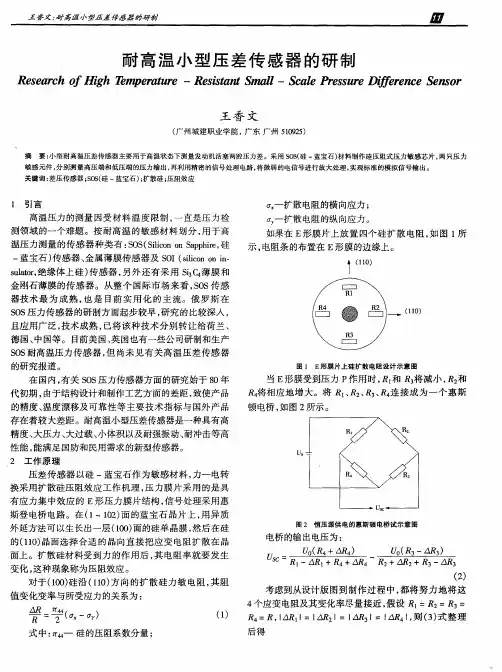
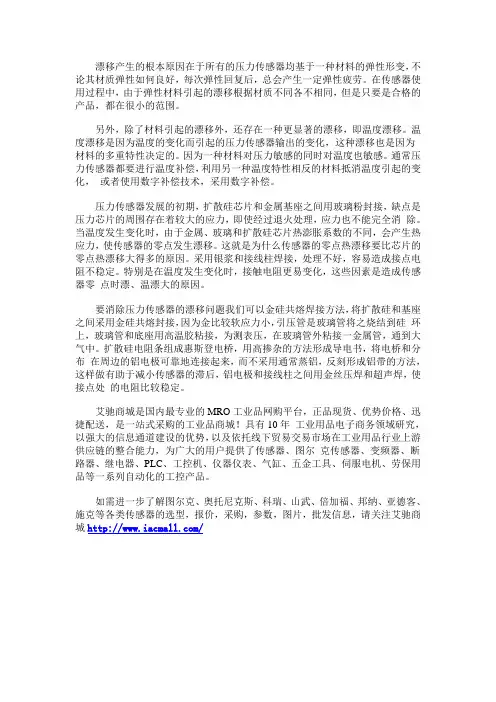
漂移产生的根本原因在于所有的压力传感器均基于一种材料的弹性形变,不论其材质弹性如何良好,每次弹性回复后,总会产生一定弹性疲劳。
在传感器使用过程中,由于弹性材料引起的漂移根据材质不同各不相同,但是只要是合格的产品,都在很小的范围。
另外,除了材料引起的漂移外,还存在一种更显著的漂移,即温度漂移。
温度漂移是因为温度的变化而引起的压力传感器输出的变化,这种漂移也是因为材料的多重特性决定的。
因为一种材料对压力敏感的同时对温度也敏感。
通常压力传感器都要进行温度补偿,利用另一种温度特性相反的材料抵消温度引起的变化,或者使用数字补偿技术,采用数字补偿。
压力传感器发展的初期,扩散硅芯片和金属基座之间用玻璃粉封接,缺点是压力芯片的周围存在着较大的应力,即使经过退火处理,应力也不能完全消除。
当温度发生变化时,由于金属、玻璃和扩散硅芯片热澎胀系数的不同,会产生热应力,使传感器的零点发生漂移。
这就是为什么传感器的零点热漂移要比芯片的零点热漂移大得多的原因。
采用银浆和接线柱焊接,处理不好,容易造成接点电阻不稳定。
特别是在温度发生变化时,接触电阻更易变化,这些因素是造成传感器零点时漂、温漂大的原因。
要消除压力传感器的漂移问题我们可以金硅共熔焊接方法,将扩散硅和基座之间采用金硅共熔封接,因为金比较软应力小,引压管是玻璃管将之烧结到硅环上,玻璃管和底座用高温胶粘接,为测表压,在玻璃管外粘接一金属管,通到大气中。
扩散硅电阻条组成惠斯登电桥,用高掺杂的方法形成导电书,将电桥和分布在周边的铝电极可靠地连接起来,而不采用通常蒸铝,反刻形成铝带的方法,这样做有助于减小传感器的滞后,铝电极和接线柱之间用金丝压焊和超声焊,使接点处的电阻比较稳定。
艾驰商城是国内最专业的MRO工业品网购平台,正品现货、优势价格、迅捷配送,是一站式采购的工业品商城!具有10年工业用品电子商务领域研究,以强大的信息通道建设的优势,以及依托线下贸易交易市场在工业用品行业上游供应链的整合能力,为广大的用户提供了传感器、图尔克传感器、变频器、断路器、继电器、PLC、工控机、仪器仪表、气缸、五金工具、伺服电机、劳保用品等一系列自动化的工控产品。
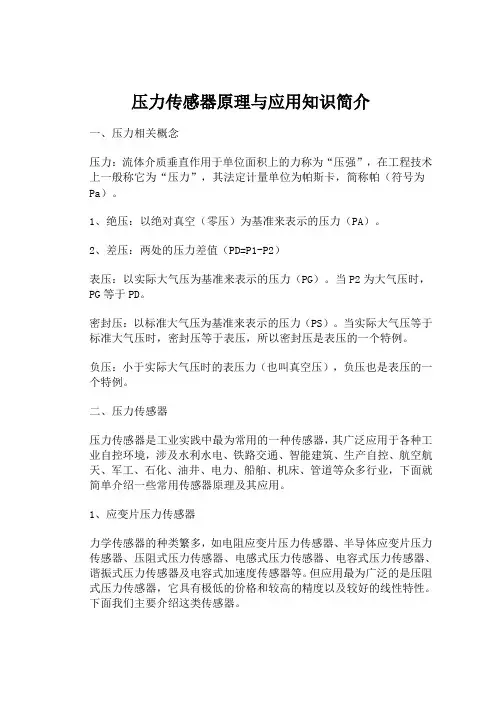
压力传感器原理与应用知识简介一、压力相关概念压力:流体介质垂直作用于单位面积上的力称为“压强”,在工程技术上一般称它为“压力”,其法定计量单位为帕斯卡,简称帕(符号为Pa)。
1、绝压:以绝对真空(零压)为基准来表示的压力(PA)。
2、差压:两处的压力差值(PD=P1-P2)表压:以实际大气压为基准来表示的压力(PG)。
当P2为大气压时,PG等于PD。
密封压:以标准大气压为基准来表示的压力(PS)。
当实际大气压等于标准大气压时,密封压等于表压,所以密封压是表压的一个特例。
负压:小于实际大气压时的表压力(也叫真空压),负压也是表压的一个特例。
二、压力传感器压力传感器是工业实践中最为常用的一种传感器,其广泛应用于各种工业自控环境,涉及水利水电、铁路交通、智能建筑、生产自控、航空航天、军工、石化、油井、电力、船舶、机床、管道等众多行业,下面就简单介绍一些常用传感器原理及其应用。
1、应变片压力传感器力学传感器的种类繁多,如电阻应变片压力传感器、半导体应变片压力传感器、压阻式压力传感器、电感式压力传感器、电容式压力传感器、谐振式压力传感器及电容式加速度传感器等。
但应用最为广泛的是压阻式压力传感器,它具有极低的价格和较高的精度以及较好的线性特性。
下面我们主要介绍这类传感器。
在了解压阻式力传感器时,我们首先认识一下电阻应变片这种元件。
电阻应变片是一种将被测件上的应变变化转换成为一种电信号的敏感器件。
它是压阻式应变传感器的主要组成部分之一。
电阻应变片应用最多的是金属电阻应变片和半导体应变片两种。
金属电阻应变片又有丝状应变片和金属箔状应变片两种。
通常是将应变片通过特殊的粘和剂紧密的粘合在产生力学应变基体上,当基体受力发生应力变化时,电阻应变片也一起产生形变,使应变片的阻值发生改变,从而使加在电阻上的电压发生变化。
这种应变片在受力时产生的阻值变化通常较小,一般这种应变片都组成应变电桥,并通过后续的仪表放大器进行放大,再传输给处理电路(通常是A/D 转换和CPU )显示或执行机构。
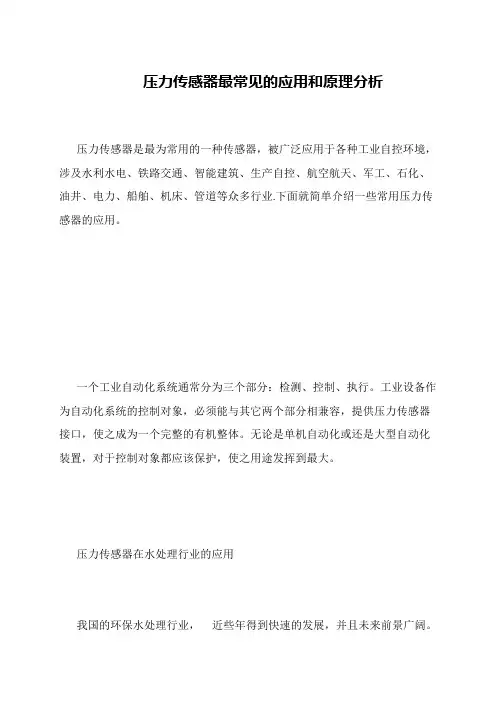
压力传感器最常见的应用和原理分析
压力传感器是最为常用的一种传感器,被广泛应用于各种工业自控环境,涉及水利水电、铁路交通、智能建筑、生产自控、航空航天、军工、石化、油井、电力、船舶、机床、管道等众多行业.下面就简单介绍一些常用压力传感器的应用。
一个工业自动化系统通常分为三个部分:检测、控制、执行。
工业设备作为自动化系统的控制对象,必须能与其它两个部分相兼容,提供压力传感器接口,使之成为一个完整的有机整体。
无论是单机自动化或还是大型自动化装置,对于控制对象都应该保护,使之用途发挥到最大。
压力传感器在水处理行业的应用
我国的环保水处理行业,近些年得到快速的发展,并且未来前景广阔。
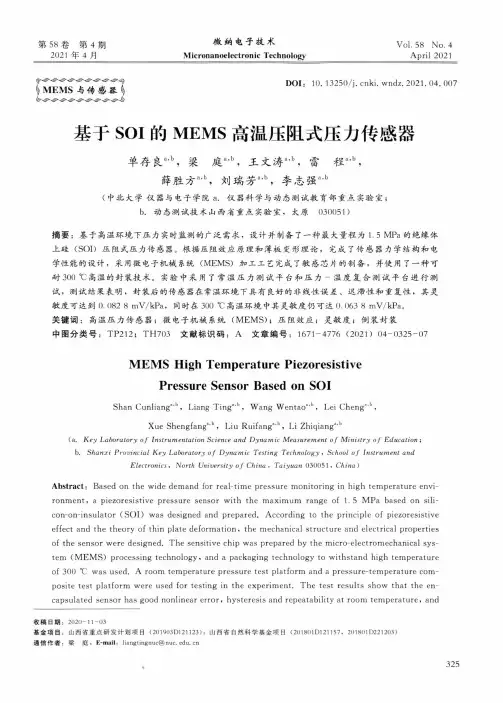
第58卷第4期 2021年4月撳纳电子技术Micronanoelectronic TechnologyVol.58 No.4April 2021t)M E M S与待感眾$DOI:10. 13250/ki.wndz.2021. 04. 007基于SO I的MEMS高温压阻式压力传感器单存良a’b,梁庭a’b,王文涛a’b,雷程a’b,薛胜方a’b,刘瑞芳a’b,李志强a’b(中北大学仪器与电子学院a.仪器科学与动态测试教育部重点实验室;b.动态测试技术山西省重点实验室,太原 030051)摘要:基于高温环境下压力实时监测的广泛需求,设计并制备了一种最大量程为1.5 MPa的绝缘体 上硅(SOI)压阻式压力传感器。
根据压阻效应原理和薄板变形理论,完成了传感器力学结构和电 学性能的设计,采用微电子机械系统(MEMS)加工工艺完成了敏感芯片的制备,并使用了一种可 耐300 °C高温的封装技术。
实验中采用了常温压力测试平台和压力-温度复合测试平台进行测试,测试结果表明,封装后的传感器在常温环境下具有良好的非线性误差、迟滞性和重复性,其灵 敏度可达到0.082 8 mV/kPa,同时在300 °C高温环境中其灵敏度仍可达0.063 8 mV/kPa。
关键词:高温压力传感器;微电子机械系统(MEMS);压阻效应;灵敏度;倒装封装中图分类号:TP212; TH703 文献标识码:A文章编号:1671-4776 (2021) ()4_0325-(_)7MEMS High Temperature PiezoresistivePressure Sensor Based on SOIShan Cunliang*,b,Liang Ting*'b,Wang Wentao8,b,Lei Chenga-b,Xue Shengfang*'b,Liu Ruifang a,b,Li Zhiqianga,b(a. Ke y Laboratory o f Instrum entation Science and D ynam ic M easurement o f M inistry o f Education;b. Sh a n xi Provincial K ey Laboratory o f D ynam ic Testing T echnology,School o f Instrum ent andElectronics, North U niversity o f China , Taiyuan030051, C hina)Abstract:Based on the wide demand for real-time pressure monitoring in high temperature environment,a piezoresistive pressure sensor with the maximum range of 1. 5 MPa based on silicon-on-insulator (SOI)was designed and prepared.According to the principle of piezoresistive effect and the theory of thin plate deformation,the mechanical structure and electrical properties of the sensor were designed.The sensitive chip was prepared by the micro-electromechanical system (MEMS)processing technology,and a packaging technology to withstand high temperature of300 °C was used.A room temperature pressure test platform and a pressure-temperature composite test platform were used for testing in the experiment.The test results show that the encapsulated sensor has good nonlinear error,hysteresis and repeatability at room temperature,and收稿日期:2020-11-03基金项目:山西省重点研发计划项目(201903D121123);山西省自然科学基金项目(201801D121157, 201801D221203)通信作者:梁庭,E-mail:********************.cn325徵M电子技术its sensitivity can reach0. 082 8 mV/kPa,while its sensitivity can still reach0. 063 8 mV/kPa at 300 °C high temperature.Keywords: high temperature pressure sensor;micro-electromechanical system(MEMS);pie-zoresistive effect;sensitivity;flip chip packageEEACC: 7230M; 2575Fo引百高温恶劣环境下,压力的原位测量需求广泛存 在于各领域中,如汽车和飞机发动机舱内部的高温 压力测量控制、航空航天飞行器外表面高温压力测 量等。
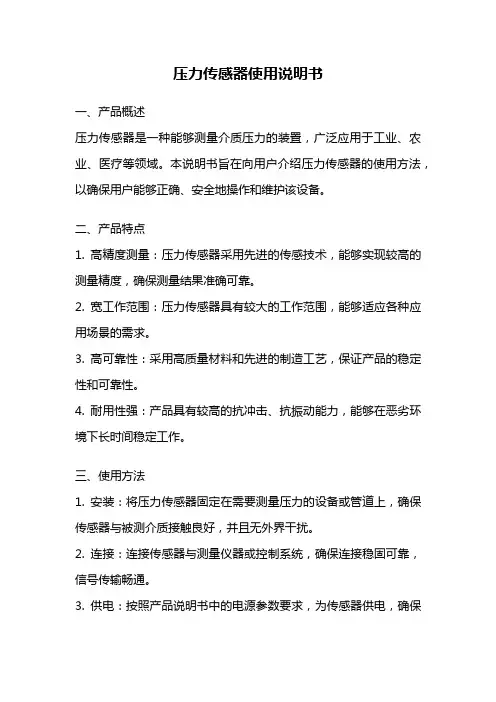
压力传感器使用说明书一、产品概述压力传感器是一种能够测量介质压力的装置,广泛应用于工业、农业、医疗等领域。
本说明书旨在向用户介绍压力传感器的使用方法,以确保用户能够正确、安全地操作和维护该设备。
二、产品特点1. 高精度测量:压力传感器采用先进的传感技术,能够实现较高的测量精度,确保测量结果准确可靠。
2. 宽工作范围:压力传感器具有较大的工作范围,能够适应各种应用场景的需求。
3. 高可靠性:采用高质量材料和先进的制造工艺,保证产品的稳定性和可靠性。
4. 耐用性强:产品具有较高的抗冲击、抗振动能力,能够在恶劣环境下长时间稳定工作。
三、使用方法1. 安装:将压力传感器固定在需要测量压力的设备或管道上,确保传感器与被测介质接触良好,并且无外界干扰。
2. 连接:连接传感器与测量仪器或控制系统,确保连接稳固可靠,信号传输畅通。
3. 供电:按照产品说明书中的电源参数要求,为传感器供电,确保电源稳定。
4. 校准:在使用前,根据实际需求进行传感器的校准,以保证测量结果的准确性。
5. 使用:根据实际需求,将被测介质加压或减压,观察测量结果,并根据需要进行相应的调整。
6. 维护:定期检查传感器的工作状态,保持传感器的清洁和干燥,避免灰尘和湿气对传感器的影响。
四、注意事项1. 请按照产品说明书中的要求使用传感器,避免超过额定工作范围,以免对设备和人员造成损害。
2. 在连接传感器时,请确保电源处于断开状态,以免触电或损坏设备。
3. 请勿私自拆卸或改装传感器,以免影响产品的性能和安全性。
4. 在清洁传感器时,请使用干净、柔软的布进行轻柔擦拭,切勿使用化学溶剂或刺激性液体。
5. 请勿将传感器暴露在高温、潮湿或腐蚀性环境中,以免损坏产品。
6. 若发现传感器工作异常或故障,请及时停止使用,并联系厂家或售后服务中心进行维修或更换。
五、故障排除1. 传感器无法正常工作:请检查供电是否正常,连接是否稳固,校准是否正确,如仍无法解决问题,请联系厂家或售后服务中心。
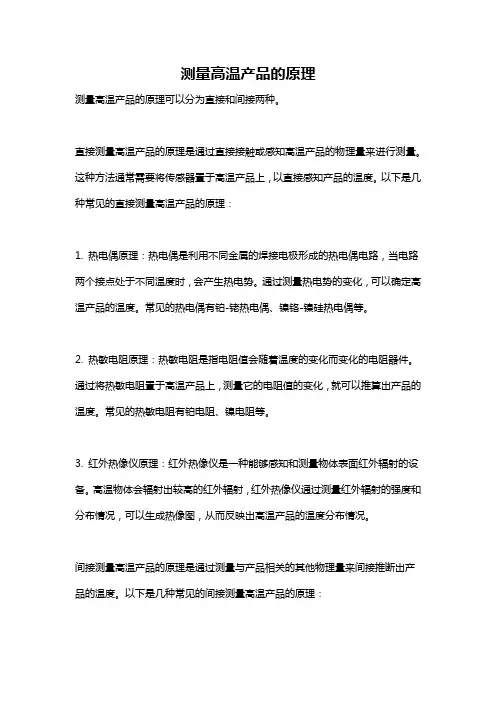
测量高温产品的原理测量高温产品的原理可以分为直接和间接两种。
直接测量高温产品的原理是通过直接接触或感知高温产品的物理量来进行测量。
这种方法通常需要将传感器置于高温产品上,以直接感知产品的温度。
以下是几种常见的直接测量高温产品的原理:1. 热电偶原理:热电偶是利用不同金属的焊接电极形成的热电偶电路,当电路两个接点处于不同温度时,会产生热电势。
通过测量热电势的变化,可以确定高温产品的温度。
常见的热电偶有铂-铑热电偶、镍铬-镍硅热电偶等。
2. 热敏电阻原理:热敏电阻是指电阻值会随着温度的变化而变化的电阻器件。
通过将热敏电阻置于高温产品上,测量它的电阻值的变化,就可以推算出产品的温度。
常见的热敏电阻有铂电阻、镍电阻等。
3. 红外热像仪原理:红外热像仪是一种能够感知和测量物体表面红外辐射的设备。
高温物体会辐射出较高的红外辐射,红外热像仪通过测量红外辐射的强度和分布情况,可以生成热像图,从而反映出高温产品的温度分布情况。
间接测量高温产品的原理是通过测量与产品相关的其他物理量来间接推断出产品的温度。
以下是几种常见的间接测量高温产品的原理:1. 热导率原理:高温产品的热导率与温度有一定的关系。
通过测量高温产品的热导率,可以推算出其温度。
热导率的测量方法有热流法、脉冲热法等。
2. 压力传感器原理:高温产品的温度变化会导致内部气体的压力变化。
通过测量高温产品的压力变化,可以间接推断出其温度。
常见的高温压力传感器有电阻应变式传感器、挠性薄膜传感器等。
3. 声速测量原理:温度的变化会影响气体的声速。
通过测量高温产品周围气体的声速,可以推算出产品的温度。
常见的声速测量方法有超声波测量法、频率移位测量法等。
以上是测量高温产品的一些常见原理。
不同的产品和应用场景可能需要不同的测量方法和传感器。
在实际应用中,需要根据具体的测量需求和环境条件选择合适的测量原理和设备来进行高温产品的测量。
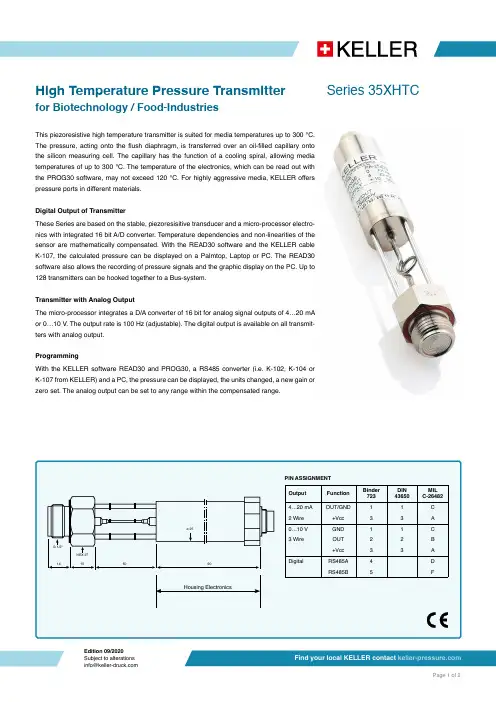
Edition 09/2020 Subject to alterations *********************Find your local KELLER contact High Temperature Pressure Transmitterfor Biotechnology / Food-IndustriesSeries 35XHTCThis piezoresistive high temperature transmitter is suited for media temperatures up to 300 °C.The pressure, acting onto the flush diaphragm, is transferred over an oil-filled capillary ontothe silicon measuring cell. The capillary has the function of a cooling spiral, allowing mediatemperatures of up to 300 °C. The temperature of the electronics, which can be read out withthe PROG30 software, may not exceed 120 °C. For highly aggressive media, KELLER offerspressure ports in different materials.Digital Output of TransmitterThese Series are based on the stable, piezoresisitive transducer and a micro-processor electro-nics with integrated 16 bit A/D converter. Temperature dependencies and non-linearities of thesensor are mathematically compensated. With the READ30 software and the KELLER cableK-107, the calculated pressure can be displayed on a Palmtop, Laptop or PC. The READ30software also allows the recording of pressure signals and the graphic display on the PC. Up to128 transmitters can be hooked together to a Bus-system.Transmitter with Analog OutputThe micro-processor integrates a D/A converter of 16 bit for analog signal outputs of 4…20 mAor 0…10 V. The output rate is 100 Hz (adjustable). The digital output is available on all transmit-ters with analog output.ProgrammingWith the KELLER software READ30 and PROG30, a RS485 converter (i.e. K-102, K-104 orK-107 from KELLER) and a PC, the pressure can be displayed, the units changed, a new gain orzero set. The analog output can be set to any range within the compensated range.Edition 09/2020 Subject to alterations *********************SpecificationsStandard Pressure Ranges (FS) and Overpressure in BarPR 35XHTC 3 10 30PAA 35XHTC 1) 10 30 100 300 1000Overpressure5206020040011001)Minimum pressure > 500 mbar abs.(digital) (analog)(analog)Output RS485 4…20 mA (2 Wire) 0…10 V (3 Wire)Supply (U) 8…28 Vcc8…28 Vcc 13…28 Vcc Accuracy, Error Band 2) (20...300 °C)3)0,5 %FS0,5 %FS 0,5 %FS2) Linearity + Hysteresis + Repeatability + Temp. Coeff. + Zero + Span Tolerance 3)Media Temperature (temperature of electronics max. 120 °C)Linearity (best straight line) 0,05 %FS True Output Rate 100 Hz Resolution0,002 %FS Long Term Stability typ.0,2 %FSLoad Resistance (Ω) <(U-7V) / 0,02A (2-wire) > 5000 (3-wire)Electrical Connection – Binder-Plug 723 (5 pole) – DIN 43650 Plug (4 pole) – MIL C-26482-Plug (6 pole)Insulation > 10 MΩ / 50 VStorage- / Operating Temperature Range Media: 0…300 °C Electronics: 0…120 °C Pressure Endurance 10 Million Pressure Cycles 0…100 %FS at 25 °C Vibration Endurance, IEC 68-2-6 20 g (5...2000 Hz, max. amplitude ± 3 mm)Shock Endurance 20 g (11 ms) Protection IP65 optional: IP67CE-Conformity EN 61000-6-1 to -6-4Material in Contact with Media Stainless Steel 316L (DIN 1.4435) / Copper Weight ≈ 300 g Dead Volume Change < 0,1 mm 3Mounting – Horizontal position (carrying-off of heat) – Cooling spiral exposed to room temperature Remark: – RS485 pins (for digital output and for programming) is available on all types.Options: – Switch output, programmable via interface– Special calculations with pressure and temperature– Different housing-material, oil filling, pressure thread or connectorPolynomial CompensationThis uses a mathematical model to derive the precise pressure value (P) from the signals measured by the pressure sensor (S) and the temperature sensor (T). The microprocessor in the transmitter calculates P using the following polynomial:P(S,T) = A(T)S 0 + B(T)S 1 + C(T)S 2 + D(T)S 3With the following coefficients A(T)…D(T)d epending on the temperature:A(T) = A 0T 0 + A 1T 1 + A 2T 2 + A 3T 3B(T) = B 0T 0 + B 1T 1 + B 2T 2 + B 3T 3C(T) = C 0T 0 + C 1T 1 + C 2T 2 + C 3T 3D(T) = D 0T 0 + D 1T 1 + D 2T 2 + D 3T 3The transmitter is factory-tested at various levels of pressure and temperature. The corresponding measured values of S, together with the exact pressure and temperature values, allow thec oefficients A 0...D 3 to be calculated. These are written into the EEPROM of the microprocessor. When the pressure transmitter is in service, the microprocessor measures the signals (S) and (T), calculates the coefficients according to the temperature and produces the exact pressure value by solving the P(S,T) equation.Calculations and conversions are performed at least 400 times per second.All intermediate ranges for the analog output are realizable with no surcharge by spreading the standard ranges.Option: Adjustment directly to intermediate ranges (below 20 pieces against surcharge).Accessories Series 30Each Series 30 transmitter also integrates a digital interface (RS485 halfduplex) which you can make use of: Connect the transmitter to a PC or Laptop via a converter RS232-RS485 (i.e. K-102, K-104 or K-107). Two programs are offered:PROG30: Instrument Settings• Call up of information (pressure- and tempe-rature range, version of software etc.)• Indication of actual pressure value• Selection of the units• Setting of a new zero and gain for thetransmitter • R eprogramming of the analog output (i.e. different unit, other pressure range)• Programming of the switch output • Changing the output rateYou can also tie up the transmitters into your own software. You have then a documentation, a DLL and numerous examples at your disposal.Changing the plug connector (optional)Laboratory applications require the same transmitter to be used at different measurement points with different electrical connection arrange-ments. To accommodate such applications, KELLER can supply different connectors matching with the internal standard plug. This makes it easy to exchange the electrical connector of the transmitter.READ30: Data collection with graphs • Fast read-out and viewing of the pressure signals in a graph • Documentation of dynamic measurements • Up to 16 transmitters on one serial connec-tion (Bus-operation)Software PROG30。

第58卷第6期2021年6月微鈉电子技术Micronanoelectronic TechnologyVol. 58 No. 6June 2021夕,,n D O I: u). 13250斤c n k i. w n d z. 2021.06.005令M E M S与铐感器$高灵敏度4H-SiC基高温压力传感器李永伟w,梁庭、雷程\李强S李志强S熊继军1(1.中北大学电子测试技术国家重点实验室,太原 030051;2.太原工业学院自动化系,太原 030051)摘要:P型4H-SiC相较n型4H-SiC具有更高的压阻效应,p型4H-S iC正方形膜片作为弹性元 件相较圆形膜片具有更高的灵敏度。
基于此,设计了一种基于p型4H-S iC压阻效应的高灵敏度 碳化硅压力传感器,探索了 Ni/Al/Ni/A u与p型4H-SiC之间形成良好欧姆接触的条件,并制备 了传感器芯片。
在25〜600 °C空气环境中对传感器芯片的电阻进行了测试,验证了传感器在<600t:下具有良好的电连接性。
最后,在常温至250 °C下对传感器进行性能测试。
实验结果显 示,常温环境下传感器具有较高的输出灵敏度为10.9 pV/V/kPa,即使在250 °C时其输出灵敏 度也约为6. 7 pV/V/kPa。
该研究为高温压阻式压力传感器发展提供了一定的技术参考。
关键词:压力传感器;微电子机械系统(MEMS);碳化硅(SiC);压阻效应;弹性元件中图分类号:TP212; TN304. 24 文献标识码:A文章编号:167卜4776 (2021) 06-0489-07H igh-Sensitivity 4H-SiC Based High Temperature Pressure SensorLi Yongwei1’2,Liang T in g1,Lei C heng1,Li Q iang1, Li Zhiqiang1, Xiong Jiju n1(1. Science a n d T echnology on E lectronic Test&- M easurem ent Laboratory <,N o rth U n iversity o f C hina,T a iy u a n030051, C hina ; 2. D epartm ent o f A u to m a tio n,T a iy u a n In stitu te o f T e c h n o lo g y,T a iy u a n030051* C h in a)Abstract:T h e piezoresistive effect of p-type 4H-SiC is more excellent than that of n-type 4H- SiC. T he p-type 4H-SiC square diaphragm as an elastic element has higher sensitivity than the circular diaphragm. Based on th is, a high sensitivity SiC pressure sensor based on the piezoresistive effect of p-type 4H-SiC was designed, the conditions of forming good ohmic contact between N i/A l/N i/A u and p-type 4H-SiC were explored, and the sensor chip was prepared. T h e resistances of the sensor chip were tested in the air at 25 ~ 600 °C. It is verified th at the sensor has good electrical connectivity when the tem perature is no more than 600 °C.Finally, the performances of the sensor were tested from room tem perature to 250 °C •T h e experim ental results show that the sensor has a high output sensitivity of 10. 9 /LtV/V/kPa at room tem perature and an output sensitivity of about 6. 7 ^V/V/k P a even at 250 °C. T h e research provides technical reference for the development of high tem perature piezoresistive pressure sensors.收稿日期:2021-01-25基金项目:国家自然科学基金重点项目(51935011);中央引导地方科技发展专项资金资助项目(YDZX2020 -1400001664);太原工业学院青年学科带头人资助项目(2020XKLG04)通信作者:梁庭,E-mail: ********************489徵鈉电子技术Key words:pressure sensor;micro-electromechanical system(MEMS);silicon carbide(SiC);piezoresistive effect;elastic elementEEA CC:7230M()引言随着控制科学与智能监测技术的发展,发动机 和石油钻井等在极端环境下的压力信号测量技术受 到了学者们的广泛关注[°。
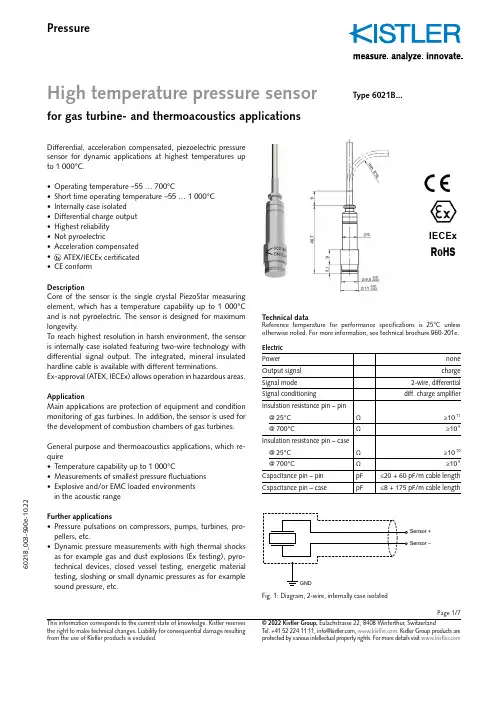
Page 1/7PressureHigh temperature pressure sensorfor gas turbine- and thermoacoustics applications6021B _003-590e -10.22© 2022 Kistler Group, Eulachstrasse 22, 8408 Winterthur, SwitzerlandT . Kistler Group products are This information corresponds to the current state of knowledge. Kistler reserves the right to make technical changes. Liability for consequential damage resulting Type 6021B...Differential, acceleration compensated, piezoelectric pressure sensor for dynamic applications at highest temperatures up to 1 000°C.• Operating temperature –55 … 700°C• Short time operating temperature –55 … 1 000°C • Internally case isolated • Differential charge output • Highest reliability • Not pyroelectric• Acceleration compensated • ATEX/IECEx certificated • CE conformDescriptionCore of the sensor is the single crystal PiezoStar measuring element, which has a temperature capability up to 1 000°C and is not pyroelectric. The sensor is designed for maximum longevity.To reach highest resolution in harsh environment, the sensor is internally case isolated featuring two-wire technology with differential signal output. The integrated, mineral insulated hardline cable is available with different terminations.Ex-approval (ATEX, IECEx) allows operation in hazardous areas.ApplicationMain applications are protection of equipment and condition monitoring of gas turbines. In addition, the sensor is used for the development of combustion chambers of gas turbines.General purpose and thermoacoustics applications, which re-quire• Temperature capability up to 1 000°C• Measurements of smallest pressure fluctuations • Explosive and/or EMC loaded environments in the acoustic rangeFurther applications• Pressure pulsations on compressors, pumps, turbines, pro-pellers, etc.• Dynamic pressure measurements with high thermal shocks as for example gas and dust explosions (Ex testing), pyro-technical devices, closed vessel testing, energetic material testing, sloshing or small dynamic pressures as for example sound pressure, etc.IECExTechnical dataReference temperature for performance specifications is 25°C unless otherwise noted. For more information, see technical brochure 960-201e.Electric Power none Output signal chargeSignal mode 2-wire, differential Signal conditioningdiff. charge amplifierInsulation resistance pin – pin @ 25°C Ω≥10 11@ 700°CΩ≥10 5Insulation resistance pin – case @ 25°C Ω≥10 10@ 700°CΩ≥10 5Capacitance pin – pin pF ≤20 + 60 pF/m cable length Capacitance pin – casepF≤8 + 175 pF/m cable lengthFig. 1: Diagram, 2-wire, internally case isolatedSensor +Sensor –RoHSPage 2/76021B _003-590e -10.22© 2022 Kistler Group, Eulachstrasse 22, 8408 Winterthur, SwitzerlandT el.+41522241111,****************,. Kistler Group products are This information corresponds to the current state of knowledge. Kistler reserves the right to make technical changes. Liability for consequential damage resulting Technical data (continuation)OperationPressure measuring range bar/psi 0 ... 100 / 0 ...1 450Calibrated partial range bar/psi 0 ... 20 / 0 (290)Overloadbar/psi 200 / 2 900Sensitivity (nom. ±10 %)pC/bar 62Thermal sensitivity shift see Fig. 2Linearity, hysteresis and repeatability%FSO ≤1Acceleration sensitivity, typical mbar/g 0.4Natural frequency, longitudinal kHz ca. 50Frequency range upper range (+10 %)Hz ca. 20 000lower range (–3 dB)Hz0.51)1)In combination with differential charge amplifier Types 5181, 5183, 5185.EnvironmentOperating temperature range Continuous °C –55 ... 700Extreme 3)°C 1 000 3)Termination°C–55 (180)LEMO PCA.0S.3027/16"-27 UNS-2A °C–55 ... 180Open leads –55 (180)Shock g <1 000Corrosion see materialHumidityHousing with integr. cable hermetically sealedConnector IP50Explosive atmosphereExplosion protection:Fig. 2: Typical thermal sensitivity shift relative to room temperatureNimonic is a registered trade mark of Special Metals Wiggins Ltd.INCONEL alloy 718 und INCONEL alloy 600 are registered trade marks of INCO family of companies.2) Special conditions for safe use are described in the instruction manual3)For detailed information please contact the local Kislter sales officePhysicalWeight sensor and cable g14 + 47 g/m cable length MaterialNimonic alloy 90 INCONEL alloy 718Cable jacket INCONEL alloy 600WireNickelPage 3/76021B _003-590e -10.22© 2022 Kistler Group, Eulachstrasse 22, 8408 Winterthur, SwitzerlandT el.+41522241111,****************,. Kistler Group products are This information corresponds to the current state of knowledge. Kistler reserves the right to make technical changes. Liability for consequential damage resulting Connector TypesFig. 3: Sensor dimensions Type 6021B... including cable terminationsType 6021B_N0A_2-pol. connector LEMO PCA.0S.302Type 6021B_N0B_2-pol. connector 7/16"-27 UNS-2AType 6021B_N0C_2-pol. open leads blackwhitePage 4/76021B _003-590e -10.22© 2022 Kistler Group, Eulachstrasse 22, 8408 Winterthur, SwitzerlandT el.+41522241111,****************,. Kistler Group products are This information corresponds to the current state of knowledge. Kistler reserves the right to make technical changes. Liability for consequential damage resulting Mounting boreFig. 4: Direct installationFig. 6: Direct installation for Sensor with 7/16" connectorFig. 5: For installation with intermediate adapter for Type 6419A21C* for installation with Kistler tools* for installation with Kistler tools* for installation with Kistler toolsSensor mountingFig. 7: Sensor installation with mounting nut Type 6419A21A and seal Type 1147A21A Fig. 8: Installation with mounting adapter Type 6419A21A, seal Type 1147A21A, and removal tool Type 6419A21BMounting nut, 16 mm hex.Tightening torque 20 Nm Type 6419A21ASeal, silver plated Type 1147A21ARemoval tool, 14 mm hex.Tightening torque 5 Nm Type 6419A21BMounting nut, 16 mm hex.Tightening torque 20 Nm Type 6419A21ASeal, silver plated Type 1147A21AFig. 9: Installation with mounting adapter Type 6419A21D andseal Type 1147A21AFig. 10: Installation with adapter Type 6419A21C, mounting nutType 6419A21A, and seal Type 1147A21A and 1147A21BMounting nut, 16 mm hex. withintermediate ring slotedTightening torque 25 NmType 6419A21DSeal, silver platedType 1147A21AMounting nut, 16 mm hex.Tightening torque 20 NmType 6419A21AAdapter, 21 mm hex.Tightening torque 60 NmType 6419A21CSeal, silver platedType 1147A21BSeal, silver platedType 1147A21ARemoval tool, 14 mm hex.Tightening torque 5 NmType 6419A21BPage 6/7© 2022 Kistler Group, Eulachstrasse 22, 8408 Winterthur, SwitzerlandT el.+41522241111,****************,. Kistler Group products are This information corresponds to the current state of knowledge. Kistler reserves the right to make technical changes. Liability for consequential damage resulting Fig. 20: Flame protection shield, Type Z21603A21FPage 7/76021B _003-590e -10.22© 2022 Kistler Group, Eulachstrasse 22, 8408 Winterthur, SwitzerlandT el.+41522241111,****************,. Kistler Group products are This information corresponds to the current state of knowledge. Kistler reserves the right to make technical changes. Liability for consequential damage resulting Ordering keyEx certificationNot Ex certificated–Ex certificated: "Ex-ia", Ex-nA"ECable termination Lemo 2 pole connector A 7/16" 2 pole connector B Open leads CCable length* 4)1 m 013 m03* Customized lengths on requestIncluded accessories Type/Mat. No.• Mounting nut 6419A21A or 6419A21D • Sealing ring, silver platted (5 pieces) 1147A21A Optional accessories Type/Mat. No.• Sealing ring, silver platted (5 pieces) 1147A21A • Sealing for intermediate adapter 1147A21B M18x1,5, silver platted • Mounting nut 6419A21A • Mounting nut 6419A21D • Insertion/removal tool 6419A21B • Adapter M18x1,5 6419A21C • Adapter M18x1,5 6419A21E • Mounting bracket for hardline cable 1423A1• Mounting tool, slotted 1251A21A • High temperature thread paste 1059• Flame protection shield Z21603A21F Optional accessories Type/Mat. No.• Softline cable 1652A...• Differential charge amplifier – Standard version 5181A – Ex-iA version 5183A – Ex-nA version 5185A4)Tolerance for cable lengths less than 1 m: +45 mm.Tolerance for cable lengths between 1 m and 5 m: +75 mm.。
压力传感器文献综述摘要:传感器技术是综合多种学科的复合型技术,是一门正在蓬勃发展的现代化传感器技术。
本文通过部分文献资料对压力传感器的发展过程、研究现状和发展趋势做一简要介绍。
关键词:压力;传感器;1 压力传感器的发展历程现代压力传感器以半导体传感器的发明为标志,而半导体传感器的发展可以分为四个阶段(1) 发明阶段(1945 - 1960 年) :这个阶段主要是以1947 年双极性晶体管的发明为标志。
此后,半导体材料的这一特性得到较广泛应用。
史密斯与1945 发现了硅与锗的压阻效应 ,即当有外力作用于半导体材料时,其电阻将明显发生变化。
依据此原理制成的压力传感器是把应变电阻片粘在金属薄膜上,即将力信号转化为电信号进行测量。
此阶段最小尺寸大约为1cm。
(2) 技术发展阶段(1960 - 1970 年) :随着硅扩散技术的发展,技术人员在硅的(001) 或(110) 晶面选择合适的晶向直接把应变电阻扩散在晶面上,然后在背面加工成凹形,形成较薄的硅弹性膜片,称为硅杯。
这种形式的硅杯传感器具有体积小、重量轻、灵敏度高、稳定性好、成本低、便于集成化的优点,实现了金属- 硅共晶体,为商业化发展提供了可能。
(3) 商业化集成加工阶段(1970 - 1980 年) :在硅杯扩散理论的基础上应用了硅的各向异性的腐蚀技术,扩散硅传感器其加工工艺以硅的各项异性腐蚀技术为主,发展成为可以自动控制硅膜厚度的硅各向异性加工技术,主要有V 形槽法、浓硼自动中止法、阳极氧化法自动中止法和微机控制自动中止法。
由于可以在多个表面同时进行腐蚀,数千个硅压力膜可以同时生产,实现了集成化的工厂加工模式,成本进一步降低。
(4) 微机械加工阶段(1980 年- 今) :上世纪末出现的纳米技术,使得微机械加工工艺成为可能。
通过微机械加工工艺可以由计算机控制加工出结构型的压力传感器,其线度可以控制在微米级范围内。
利用这一技术可以加工、蚀刻微米级的沟、条、膜,使得压力传感器进入了微米阶段。
四种压力传感器的基本工作原理及特点一:电阻应变式传感器1 1电阻应变式传感器定义被测的动态压力作用在弹性敏感元件上,使它产生变形,在其变形的部位粘贴有电阻应变片,电阻应变片感受动态压力的变化,按这种原理设计的传感器称为电阻应变式压力传感器。
1.2 电阻应变式传感器的工作原理电阻应变式传感器所粘贴的金属电阻应变片主要有丝式应变片与箔式应变片。
箔式应变片是以厚度为0.002——0.008mm的金属箔片作为敏感栅材料,,箔栅宽度为0.003——0.008mm。
丝式应变片是由一根具有高电阻系数的电阻丝(直径0.015--0.05mm),平行地排成栅形(一般2——40条),电阻值60——200 ?,通常为120 ?,牢贴在薄纸片上,电阻纸两端焊有引出线,表面覆一层薄纸,即制成了纸基的电阻丝式应变片。
测量时,用特制的胶水将金属电阻应变片粘贴于待测的弹性敏感元件表面上,弹性敏感元件随着动态压力而产生变形时,电阻片也跟随变形。
如下图所示。
B为栅宽,L为基长。
材料的电阻变化率由下式决定:R Ad d d(1)R A式中;R—材料电阻由材料力学知识得;[(12)(12)]dRR C K (2)K —金属电阻应变片的敏感度系数式中K 对于确定购金属材料在一定的范围内为一常数,将微分dR 、dL 改写成增量ΔR 、ΔL,可得RLK K R L (3) 由式(2)可知,当弹性敏感元件受到动态压力作用后随之产生相应的变形ε,而形应变值可由丝式应变片或箔式应变片测出,从而得到了ΔR 的变化,也就得到了动态压力的变化,基于这种应变效应的原理实现了动态压力的测量。
1.3电阻应变式传感器的分类及特点测低压用的膜片式压力传感器常用的电阻应变式压力传感器包括测中压用的膜片——应变筒式压力传感器测高压用的应变筒式压力传感器1.3.1膜片——应变筒式压力传感器的特点该传感器的特点是具有较高的强度和抗冲击稳定性,具有优良的静态特性、动态特性和较高的自震频率,可达30khz 以上,测量的上限压力可达到9.6mp a 。
中高温压力传感器
传感器简介:
普通压阻式压力传感器其敏感测控惠斯顿全桥的四个力敏电阻是用集成电路工艺制
造的,电阻间用PN结相互隔离,由于受到PN结耐温限制,最高使用温度125℃ ,而实际
上由于PN结反向露电流随温度指数上升关系,在温度超过100℃后,传感器性能已大大劣
化,限制普通压阻传感器的可用温度范围,利用陶瓷厚膜技术可将温度提高至125℃;还可
以利用多晶SOI技术制作力敏电阻,可将温度扩展至到200℃;利用隔离一体或加散热片可
将温度提高到250℃,要想温度达到400℃,可做高温水冷式,本系列产品同时设计成高频
动瞬时高温1000℃。
传感器分类:
一、CYG1601型中高温压力传感器
1. 量程:0--10Kpa至0—40Mpa
2. 测量介质:适用于非腐蚀性、非导电性气体介质的压力测量。
3. 过载能力:200%FS
4. 补偿温度:0℃--90℃
5. 使用温度:-40℃--130℃
6. 压力接口: M12×1、74度锥角, M20×1.5
7. 出线方式:航插, 霍斯曼, 电缆琐头直出线
8. 供电方式:18~36V 典型24V
9. 输出方式:4~20mV
二、CYG1602中高温压力传感器
1. 量程0--4Kpa至0—100Mpa
2. 测量介质:适用于非腐蚀性介质的压力测量。
3. 过载能力:150%FS
4. 补偿温度:-40℃--120℃
5. 测量介质温度:-40℃--150℃ (使用环境温度: -40℃--120℃)
6. 压力接口: M20×1.5 其它可订制
7. 出线方式:航插, 霍斯曼, 电缆琐头直出线
8. 供电方式:18~36V 典型24V
9. 输出方式:4~20mV
三、CYG603中高温压力传感器
1. 量程0--10Kpa至0—40Mpa
2. 测量介质:适用于非腐蚀性、非导电性气体介质的压力测量。
3. 过载能力:200%FS
4. 补偿温度:0℃--150℃
5. 使用温度:-40℃--200℃
6. 压力接口:M12×1、74度锥角, M20×1.5
7. 出线方式:航插, 霍斯曼, 电缆琐头直出线
8. 供电方式:18~36V 典型24V
9. 输出方式:4~20mV
三、CYG609型水冷高温
1. 量程0--10Kpa 0—10Mpa
2. 测量介质:适用于非腐蚀性、非导电性气体介质的压力测量。
3. 过载能力:200%FS
4. 补偿温度:0℃--150℃
5. 测量介质温度:-40℃--450℃
6. 压力接口: M12×1、74度锥角, M20×1.5
7. 出线方式: 航插, 霍斯曼, 电缆琐头直出线
8. 供电方式:恒压供电12V或15V. 恒流1mA—8mA
9. 输出方式:差分毫伏信号
CYG1600中高温压力变送器
各传感器型号均可配置 ①.信号输出4—20mA产品,标准供电电源为24VDV.②.信号输出
0—5V 产品,标准供电电源为12VDV、24VDV、±12V或±15V
凡订压力变送器在原传感器型号三位前加“1”,
例:CYG602高温压传感器,CYG1602高温压力变送器。